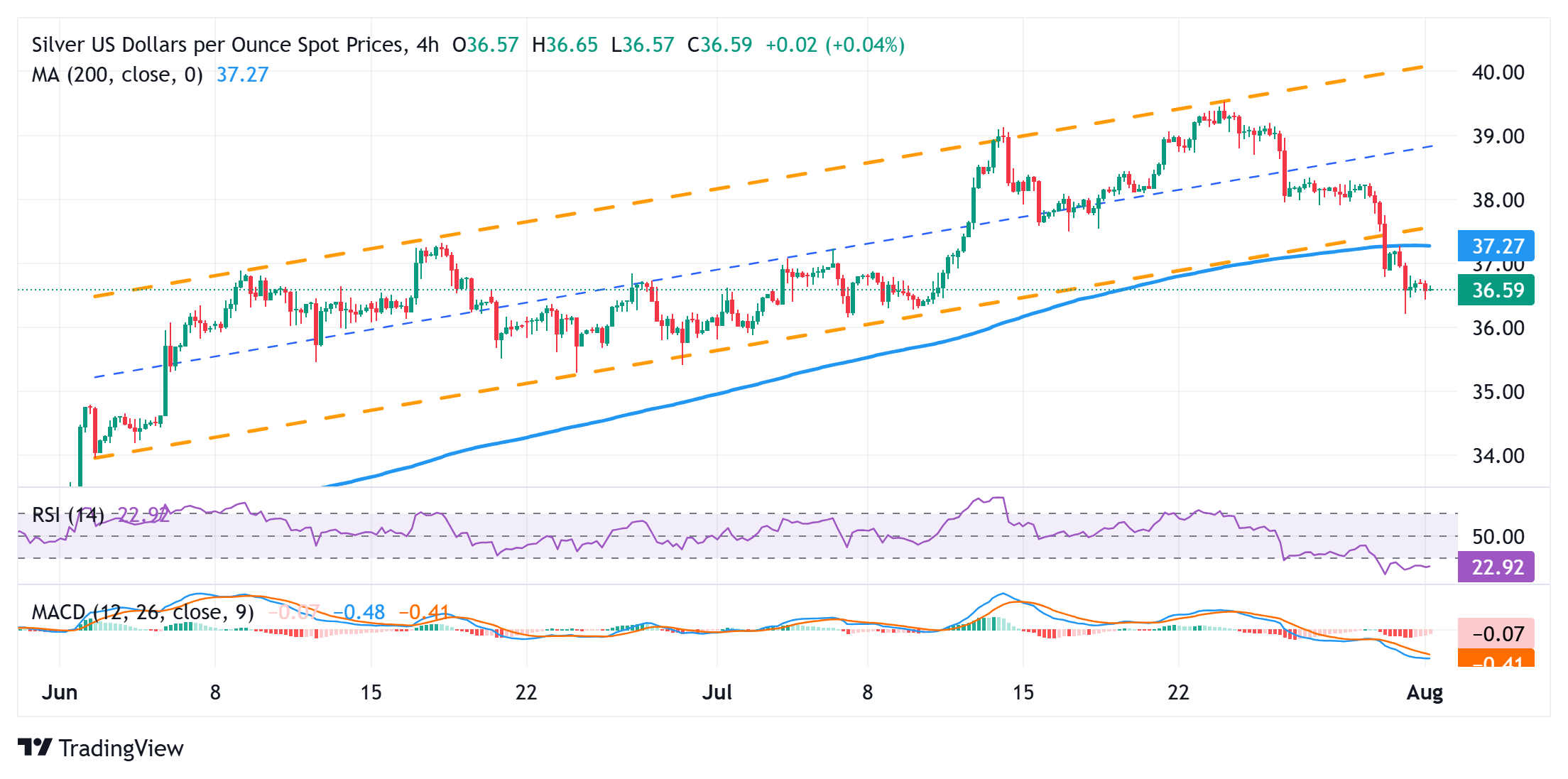Silver Price Forecast: XAG/USD seems vulnerable; ascending channel breakdown in play
- Silver remains depressed near a multi-week trough touched the previous day.
- The recent breakdown below an ascending channel favors the XAG/USD bears.
- Any attempted recovery is likely to face stiff resistance near the $37.00 mark.
Silver (XAG/USD) struggles to capitalize on the overnight modest rebound from the $36.20 area, or a nearly four-week low, and trades with a negative bias during the Asian session on Friday. The white metal currently trades around he $36.65-36.60 region, down 0.15% for the day, though it lacks follow-through selling as traders opt to wait for the release of the US Nonfarm Payrolls (NFP) report.
From a technical perspective, this week's breakdown below a nearly two-month-old ascending channel support, which coincided with the 200-period Simple Moving Average (SMA) on the 4-hour chart, was seen as a key trigger for the XAG/USD bears. Moreover, oscillators on the daily chart have just started gaining negative traction, suggesting that the path of least resistance for the commodity is to the downside.
However, the Relative Strength Index (RSI) on the 4-hour chart is already flashing oversold conditions and makes it prudent to wait for some near-term consolidation or a modest recovery before positioning for any further depreciating move. Nevertheless, the XAG/USD seems vulnerable to weaken further below the multi-week low, around the $36.20 region, and the $36.00 mark, towards the $35.50 support zone.
On the flip side, any meaningful recovery attempt is likely to confront a stiff barrier ahead of the $37.00 round figure. A sustained strength above, however, might trigger a short-covering rally, though it runs the risk of fizzling out near the $37.55-$37.60 confluence support breakpoint. The latter should act as a pivotal point, which, if cleared, will negate the negative bias and shift the bias in favor of the XAG/USD bulls.
Silver 4-hour chart

Silver FAQs
Silver is a precious metal highly traded among investors. It has been historically used as a store of value and a medium of exchange. Although less popular than Gold, traders may turn to Silver to diversify their investment portfolio, for its intrinsic value or as a potential hedge during high-inflation periods. Investors can buy physical Silver, in coins or in bars, or trade it through vehicles such as Exchange Traded Funds, which track its price on international markets.
Silver prices can move due to a wide range of factors. Geopolitical instability or fears of a deep recession can make Silver price escalate due to its safe-haven status, although to a lesser extent than Gold's. As a yieldless asset, Silver tends to rise with lower interest rates. Its moves also depend on how the US Dollar (USD) behaves as the asset is priced in dollars (XAG/USD). A strong Dollar tends to keep the price of Silver at bay, whereas a weaker Dollar is likely to propel prices up. Other factors such as investment demand, mining supply – Silver is much more abundant than Gold – and recycling rates can also affect prices.
Silver is widely used in industry, particularly in sectors such as electronics or solar energy, as it has one of the highest electric conductivity of all metals – more than Copper and Gold. A surge in demand can increase prices, while a decline tends to lower them. Dynamics in the US, Chinese and Indian economies can also contribute to price swings: for the US and particularly China, their big industrial sectors use Silver in various processes; in India, consumers’ demand for the precious metal for jewellery also plays a key role in setting prices.
Silver prices tend to follow Gold's moves. When Gold prices rise, Silver typically follows suit, as their status as safe-haven assets is similar. The Gold/Silver ratio, which shows the number of ounces of Silver needed to equal the value of one ounce of Gold, may help to determine the relative valuation between both metals. Some investors may consider a high ratio as an indicator that Silver is undervalued, or Gold is overvalued. On the contrary, a low ratio might suggest that Gold is undervalued relative to Silver.






